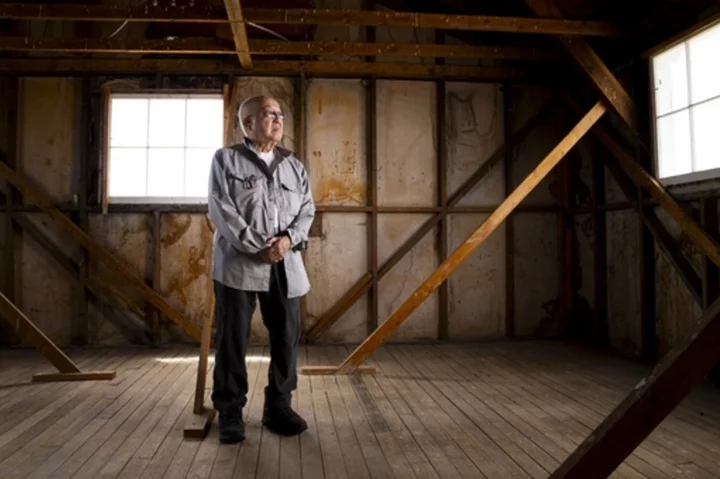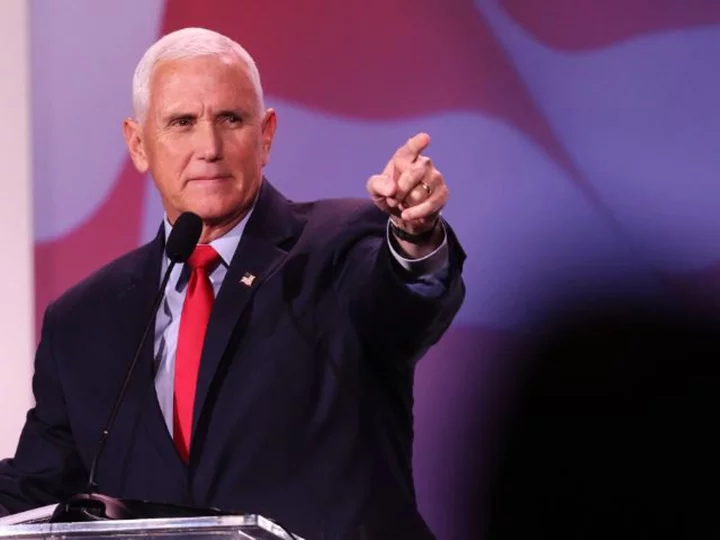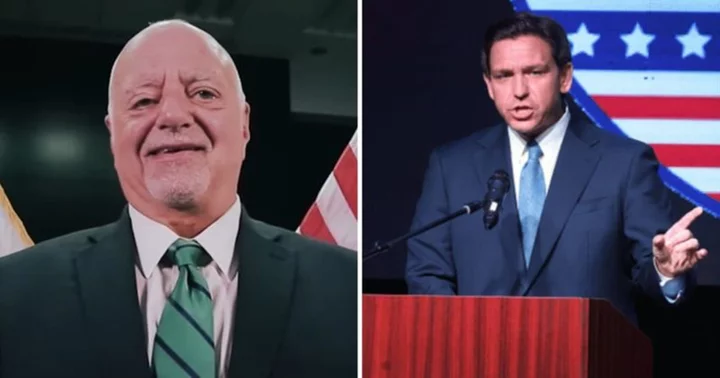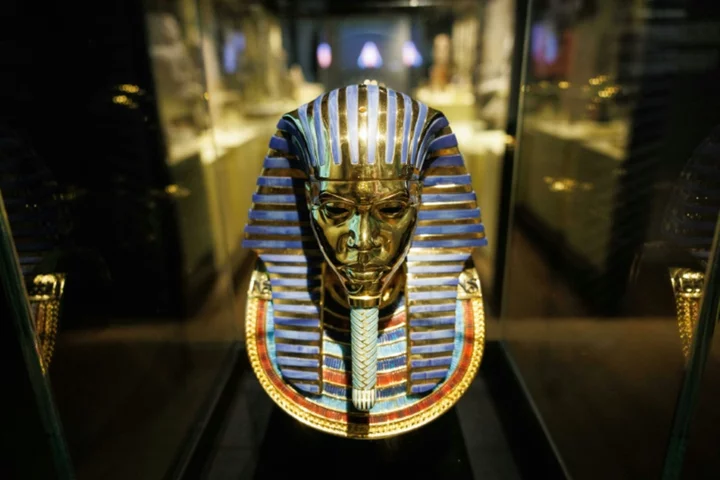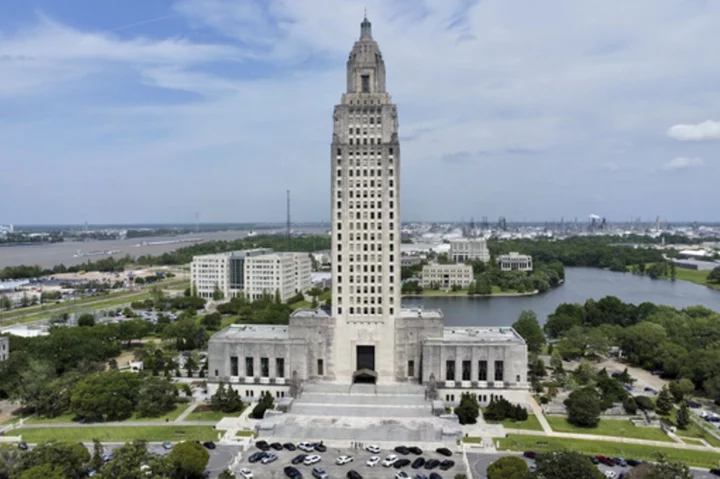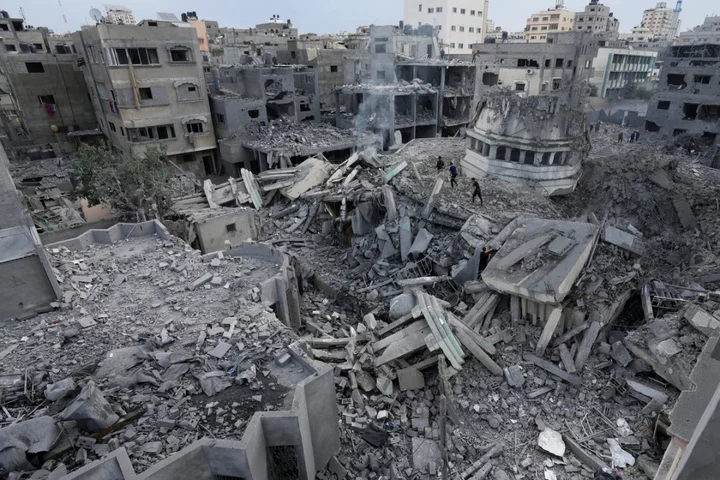JEROME, Idaho (AP) — Behind the barbed wire, the little boy pressed his ink-covered index finger onto the mint-green exit card. And a photograph was snapped of his frightened face.
Paul Tomita was four.
It was July 4, 1943. Independence Day at Minidoka, a camp in the vast Idaho desert, where over 13,000 Japanese American men, women and children were incarcerated during World War II as security risks because of their ancestry.
The wallet-sized paper meant the scared boy in the photo could leave after 11 months living in a cramped barracks with his father, mother, two sisters and grandmother.
Eight decades later, he returned with West Coast pilgrims who think the life-changing atrocity should be remembered. But now another government decision looms as a new threat — a wind project the pilgrims worry will destroy the experience they want to preserve.
If approved by the Bureau of Land Management, the Lava Ridge Wind Farm would put up 400 turbines on 118 square miles (306 square kilometers) near Minidoka, where survivors say they are witnessing another attempt to bury the past.
“If Minidoka was a white memorial to white soldiers who died in whatever war it is, do you think that they would offer free land to Lava Ridge to develop their windmills there?” Tomita said. "Hell no.”
THE CAMP IN THE DESERT
Two months after the Japan's Dec. 7, 1941 attack on Pearl Harbor, President Franklin D. Roosevelt signed Executive Order 9066.
Roughly 120,000 people of Japanese ancestry were taken from their homes and incarcerated in camps as a potential threat against the U.S.
Thousands were elderly, disabled, children or infants. Desperate families sold belongings and packed what they could. Luckier ones had white friends care for houses, farms and businesses.
At Minidoka, they lived in wooden, tarpaper-covered barracks, braving summer heat and winter cold on 50 square miles (130 square kilometers) of remote, high desert. In tight quarters without much privacy, women waited until nighttime to use latrines. Up to eight family members shared rooms on cots without mattresses. For Christmas dinner, children ate hot dogs.
Under armed guard towers, Minidoka residents worked in fields cultivating crops for little pay. But they built a community in what was essentially a prison camp.
They organized churches and planted gardens. They created city of sorts with stores, watch and radio repair shops, a health clinic, a barbershop, an ice rink, a swimming pool and a baseball diamond.
Today, few original structures remain as reminders of a chapter in U.S. history the government worked to erase before issuing reparations and designating camps national historic sites decades later.
Now, a new project with fences of a different kind is envisioned for the wide-open public land dotted with sagebrush and cheatgrass.
WIND PROJECT OPPOSED
As the Biden Administration aimed to fight climate change by permitting 25 gigawatts of renewable energy on public lands within the decade, a company named Magic Valley pitched a wind farm that would be the second-largest in the U.S. and produce up to 1,000 megawatts.
Lava Ridge would erect towering turbines in parts of three counties and double Idaho's wind energy production.
“There is a tremendous need, a market based need for clean energy in Idaho and across the West ... being requested by utilities, by businesses, by state leaders, and really by many Americans who are trying to get this country toward energy independence,” said Luke Papez, project manager at Magic Valley, a subsidiary of New York-based LS Power. "This is a very good site to locate a project.”
With global warming, wind farms have been framed as avenues to increased economic activity, new local tax revenues — and a vital tool for the White House's clean energy goals.
“Renewable wind projects are a critical component of the Biden-Harris administration’s commitment to confronting climate change, promoting clean air and water for our current and future generations, creating thousands of good-paying union jobs, and jump starting our country’s transition to a clean energy future,” said Interior Secretary Deb Haaland in a statement.
Magic Valley now hopes to win BLM approval next year and to begin construction in 2025 and start operations by 2026.
But opposition is nearly universal in the high desert where the company would build hundreds of miles of temporary fencing and roads, plus hundreds of concrete slabs for turbines.
There are fears the isolated landscape that draws travelers will be permanently scarred, explosives used for construction will damage an aquifer — and the project will cast shadows on the desert Minidoka survivors visit.
As the BLM nears a final decision, Minidoka survivors and descendants are declaring the site a place of healing that commemorates traumas their families still struggle to unpack and resolve.
“I don’t mean to take sides in history,” said Idaho Rep. Jack Nelson, a Republican. “But the reason we study history is so we don’t do those things again.”
THE BOY IN THE PHOTO
During his 11 months at the desert camp, Paul Tomita longed for his Seattle home surrounded by lush greenery. He asked his mother: What did we do wrong to end up here? When are we going home?
“Of course, my mom had to song and dance around it,” recalled Tomita, now 84. “Even though I was that young, I knew something was wrong."
Tomita's family and thousands of other Japanese Americans were under control of the Army’s War Relocation Authority. “They told us when we could eat, when we could sleep, when we could do anything,” he said.
Unrelenting dust in their single room worsened his asthma and sent him repeatedly to the hospital barracks.
When thick desert dust blew through holes in the family's barracks walls, his mother dunked newspaper in water to plaster the biggest ones. But the material dried and crumbled.
“Dust on your face, dust in your ears, dust up your nose, dust in your mouth," Tomita recalled.
Eventually, Tomita said, U.S. soldiers on the other side of the barbed wire knew the Japanese-Americans at Minidoka were not a threat. “Even if we got through the fences,” he said, "where are we going to go?”
LEAVING, BUT NEVER FORGETTING
While Tomita's family was incarcerated, his father applied for an East Coast job with the Office of Strategic Services — a precursor of the CIA.
His assignment: Translating U.S. propaganda into Japanese flyers urging surrender that would be dropped in the South Pacific.
To return to life outside, Tomita, his older sister and his younger sister, then 2, needed a leave card with a fingerprint and photo.
At war's end, the family returned to Seattle, where neighbors had safeguarded typesetting equipment that allowed them to restart the family printing business.
When the children entered high school, their mother presented them with their Minidoka exit cards.
After earning a master’s degree in rehabilitation counseling at Oregon State University, Tomita provided consulting and rehabilitation services to companies and government agencies on the West Coast. He and his wife adopted a daughter, now 53 with a child of her own.
In July, Tomita brought a copy of his exit card when he returned to the camp for an annual pilgrimage. He wants future generations to be able to visit this treasured site for Japanese-Americans.
“Because they dumped us there,” he said. “Like it or not, it is our sacred land."
___
Associated Press climate and environmental coverage receives support from several private foundations. See more about AP’s climate initiative here. The AP is solely responsible for all content.

